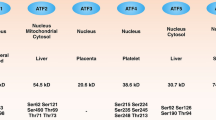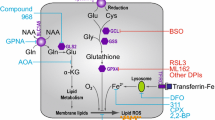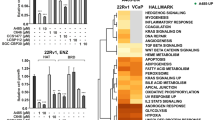Abstract
We previously reported that antiestrogen-liganded estrogen receptor β (ERβ) transcriptionally activates the major detoxifying enzyme quinone reductase (QR) (NAD(P)H:quinone oxidoreductase). Our studies also indicate that upregulation of QR, either by overexpression or induction by tamoxifen, can protect breast cells against oxidative DNA damage caused by estrogen metabolites. We now report on the upregulation of glutathione S-transferases Pi (GST-Pi) and gamma-glutamylcysteine synthetase heavy subunit (GCSh) expression by antiestrogens. Studies indicate the regulation of GST-Pi and GCSh transcriptional activity by ER. While ER regulation is mediated by an electrophile response element (EpRE), we identified mechanistic differences in the involvement of other transcription factors. Regardless of these differences, ERβ-mediated regulation of GST-Pi and GCSh point towards an important role for ERβ in cellular protection against oxidative stress. A protective role is supported by our observation of inhibition of estrogen-induced DNA damage upon upregulation of GST-Pi and GCSh expression.







Similar content being viewed by others
Abbreviations
- ERβ:
-
estrogen receptor β
- ERα:
-
estrogen receptor α
- E2:
-
17β-estradiol
- TOT:
-
trans-hydroxytamoxifen
- QR:
-
quinone reductase
- GST-Pi:
-
glutathione S-transferases Pi
- GCSh:
-
gamma-glutamylcysteine synthetase heavy subunit
- ARE/EpRE:
-
antioxidant/electrophile response element
- 8-OHdG:
-
8-hydroxydeoxyguanine
References
Bianco NR and Montano MM . (2002). Oncogene, 21, 5233–5244.
Bianco NR, Perry G, Smith MA, Templeton DJ and Montano MM . (2003). Mol. Endocrinol., 17, 1344–1355.
Cha YN and Heine HS . (1982). Cancer Res., 42, 2609–2615.
Dahl EL and Mulcahy RT . (2001). Toxicol. Sci., 61, 265–272.
Dhakshinamoorthy S, Long DJ and Jaiswal AK . (2000). Curr. Top. Cell. Regul., 36, 201–216.
Esteller M, Corn PG, Urena JM, Gabrielson E, Baylin SB and Herman JG . (1998). Cancer Res., 58, 4515–4518.
Gamcsik MP, Dubay GR and Cox BR . (2002). Biochem. Pharmacol., 63, 843–851.
Griffith OW and Mulcahy RT . (1999). Adv. Enzymol. Relat. Areas Mol. Biol., 73, 209–267.
Hellriegel ET, Matwyshyn GA, Fei P, Dragnew KH, Nims RW, Lubet R A and Kong AT . (1996). Biochem. Pharmacol., 52, 1561–1568.
Jaiswal AK . (2000). Free Radic. Biol. Med., 29, 254–262.
Jhaveri MS and Morrow CS . (1998a). Biochim. Biophys. Acta, 1396, 179–190.
Jhaveri MS and Morrow CS . (1998b). Gene, 210, 1–7.
Kyo S, Takakura M, Kanaya T, Zhuo W, Fujimoto K, Nishio Y, Orimo A and Inoue M . (1999). Cancer Res., 59, 5917–5921.
Liu RM, Gao L, Choi J and Forman HJ . (1998). Am. J. Physiol., 275, L861–L869.
Matsumoto M, Imagawa M and Aoki Y . (2000). Biochem. J., 349, 225–230.
Maugard CM, Charrier J, Pitard A, Campion L, Akande O, Pleasants L and Ali-Osman F . (2001). Int. J. Cancer, 91, 334–339.
Misiti S, Nanni S, Fontemaggi G, Cong YS, Wen J, Hirte HW, Piaggio G, Sacchi A, Pontecorvi A, Bacchetti S and Farsetti A . (2000). Mol. Cell. Biol., 20, 3764–3771.
Mitrunen K, Jourenkova N, Kataja V, Eskelinen M, Kosma VM, Benhamou S, Vainio H, Uusitupa M and Hirvonen A . (2001). Cancer Epidemiol. Biomarkers Prev., 10, 229–236.
Mizutani K, Ikeda K, Nishikata T and Yamori Y . (2000). J. Hypertens., 18, 1833–1840.
Moffat GJ, McLaren AW and Wolf CR . (1994). J. Biol. Chem., 269, 16397–16402.
Moffat GJ, McLaren AW and Wolf CR . (1996). J. Biol. Chem., 271, 20740–20747.
Moinova HR and Mulcahy RT . (1998). J. Biol. Chem., 273, 14683–14689.
Montano MM, Jaiswal AK and Katzenellenbogen . (1998). J. Biol. Chem., 273, 25443–25449.
Montano MM and Katzenellenbogen BS . (1997). Proc. Natl. Acad. Sci. USA, 94, 2581–2586.
Montano MM, Wittmann BM and Bianco NR . (2000). J. Biol. Chem., 275, 34306–34313.
Morrow CS, Goldsmith ME and Cowan KH . (1990). Gene, 88, 215–222.
Mulcahy RT, Wartman MA, Bailey HH and Gipp JJ . (1997). J. Biol. Chem., 272, 7445–7454.
Nanni S, Narducci M, Della Pietra L, Moretti F, Grasselli A, De Carli P, Sacchi A, Pontecorvi A and Farsetti A . (2002). J. Clin. Invest., 110, 219–227.
Paech K, Webb P, Kuiper GG, Nilsson S, Gustafsson J, Kushner PJ and Scanlan TS . (1997). Science, 277, 1508–1510.
Paulus W, Baur I, Boyce FM, Breakfield XO and Reeves SA . (1996). J.Virol., 70, 62–67.
Prestera T, Zhang Y, Spencer S R, Wilczak C A and Talalay P . (1993). Adv. Enzyme Reg., 33, 281–296.
Rahman I and MacNee W . (1999). Am. J. Physiol., 277, L1067–L1088.
Safe S . (2001). Vitam. Horm., 62, 231–252.
Singal R and Ginder GD . (1999). Blood, 93, 4059–4070.
Singal R, van Wert J and Bashambu M . (2001). Cancer Res., 61, 4820–4826.
Strange RC, Spiteri MA, Ramachandran S and Fryer AA . (2001). Mutat. Res., 82, 21–26.
Talalay P . (1989). Adv. Enzyme Reg., 28, 237–250.
Tew KD . (1994). Cancer Res., 54, 4313–4320.
Walsh AC, Feulner JA and Reilly A . (2001). Toxicol. Sci., 61, 218–223.
Wild AC, Moinova HR and Mulcahy RT . (1999). J. Biol. Chem., 274, 33627–33636.
Wilkinson IV J, Radjendirane V, Pfeiffer GR, Jaiswal AK and Clapper ML . (1998). Biochem. Biophys. Res. Commun., 253, 855–858.
Xia C, Taylor JB, Spencer SR and Ketterer B . (1993). Biochem. J., 292, 845–850.
Yoshida T, Eguchi H, Nakachi K, Tanimoto K, Higashi Y, Suemasu K, Iino Y, Morishita Y and Hayashi S . (2000). Carcinogenesis, 21, 2193–2201.
Zhang Y and Dufau ML . (2003). J. Steroid Biochem. Mol. Biol, 85, 401–414.
Acknowledgements
We thank Dr Steven A Reeves (Massachusetts General Hospital) for the pBPSTR1 retroviral vector, Dr Henry Forman (University of Alabama) for the GCSh antibody, and Dr R Timothy Mulchay (University of Wisconsin) for the GCSh-pGL3 reporter.
Author information
Authors and Affiliations
Corresponding author
Additional information
This work was supported by National Institute of Health Grant CA80959 to MMM
Rights and permissions
About this article
Cite this article
Montano, M., Deng, H., Liu, M. et al. Transcriptional regulation by the estrogen receptor of antioxidative stress enzymes and its functional implications. Oncogene 23, 2442–2453 (2004). https://doi.org/10.1038/sj.onc.1207358
Received:
Revised:
Accepted:
Published:
Issue Date:
DOI: https://doi.org/10.1038/sj.onc.1207358
- Springer Nature Limited
Keywords
This article is cited by
-
Detection and functional characterization of sigma class GST in Phlebotomus argentipes and its role in stress tolerance and DDT resistance
Scientific Reports (2019)
-
Oestrogen receptor-regulated glutathione S-transferase mu 3 expression attenuates hydrogen peroxide-induced cytotoxicity, which confers tamoxifen resistance on breast cancer cells
Breast Cancer Research and Treatment (2018)
-
The prognostic and predictive power of redox protein expression for anthracycline-based chemotherapy response in locally advanced breast cancer
Modern Pathology (2012)
-
The exonuclease activity of hPMC2 is required for transcriptional regulation of the QR gene and repair of estrogen-induced abasic sites
Oncogene (2011)
-
Interdependence between Heme Oxygenase-1 Induction and Estrogen-Receptor-β Signaling Mediates Photoimmune Protection by UVA Radiation in Mice
Journal of Investigative Dermatology (2009)




